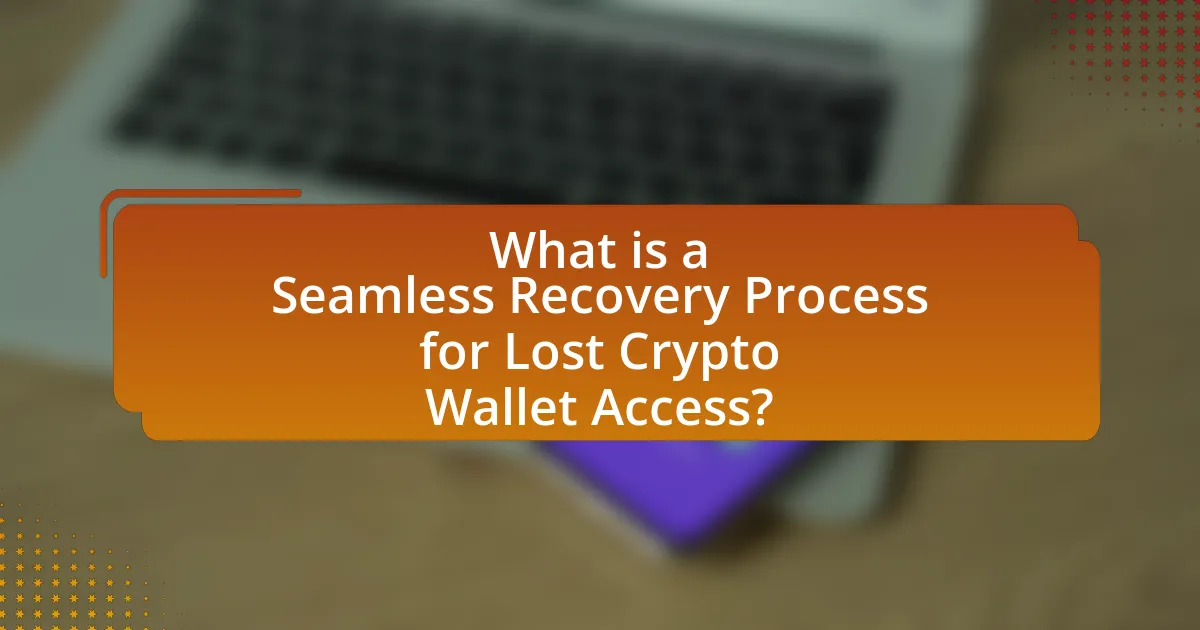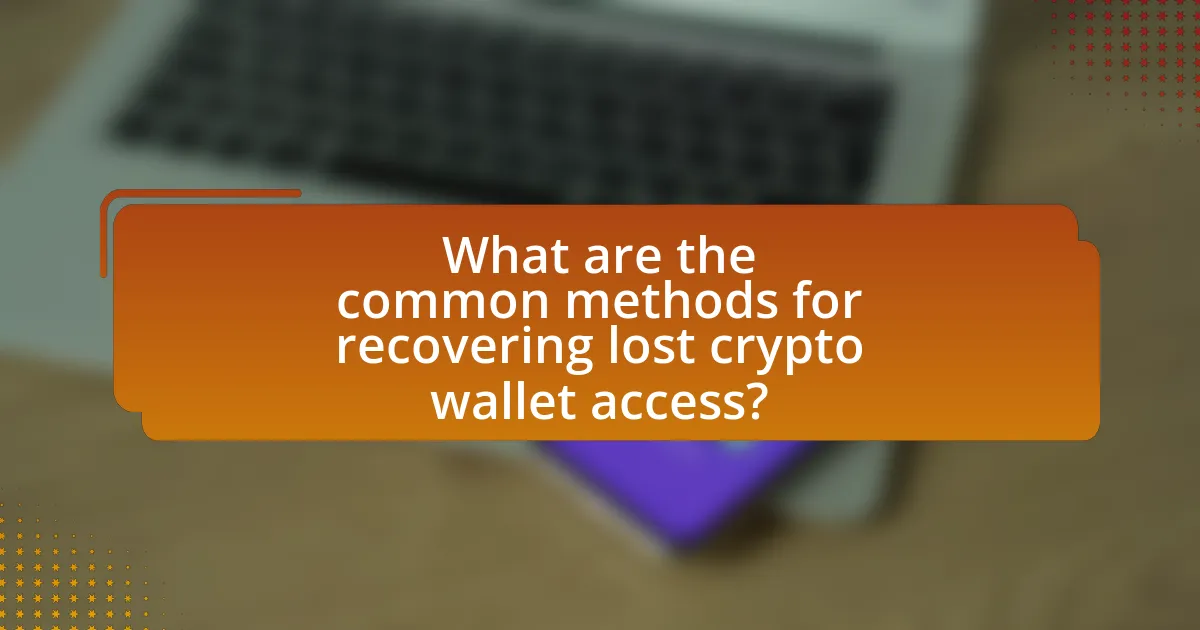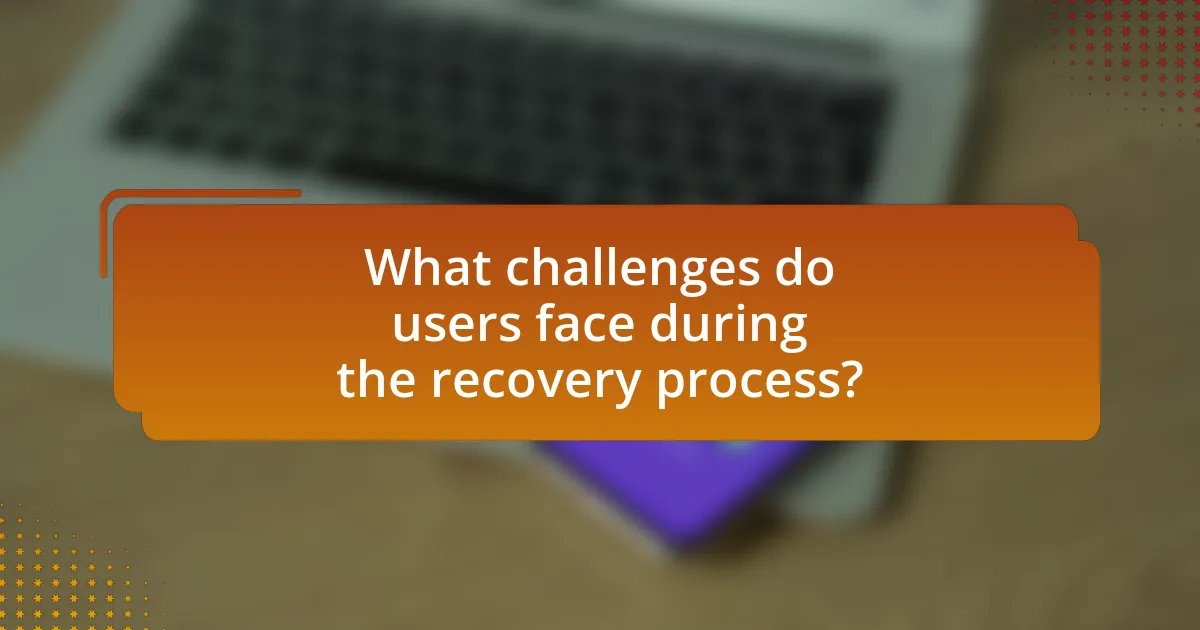The article focuses on the seamless recovery process for lost crypto wallet access, emphasizing the importance of effective recovery mechanisms in the cryptocurrency ecosystem. It outlines the systematic steps involved in regaining access, including the use of recovery phrases, seed phrases, and various wallet types, each with distinct recovery procedures. The article also highlights the risks users face without proper recovery processes, the challenges encountered during recovery, and best practices for safeguarding access to digital assets. Additionally, it discusses tools, resources, and community support that can aid users in their recovery efforts, ultimately aiming to enhance user confidence and security in managing cryptocurrency wallets.

What is a Seamless Recovery Process for Lost Crypto Wallet Access?
A seamless recovery process for lost crypto wallet access involves a systematic approach that enables users to regain access to their wallets without significant difficulty. This process typically includes utilizing recovery phrases or seed phrases, which are unique strings of words generated during wallet creation, allowing users to restore their wallets on compatible platforms. Additionally, some wallets offer multi-signature features or backup options that enhance security and recovery capabilities. The effectiveness of this process is underscored by the fact that approximately 20% of Bitcoin is considered lost due to inaccessible wallets, highlighting the importance of robust recovery mechanisms in the cryptocurrency ecosystem.
How does the recovery process work for lost crypto wallet access?
The recovery process for lost crypto wallet access typically involves using a recovery phrase or seed phrase that was generated during the wallet setup. This phrase, usually consisting of 12 to 24 words, allows users to restore their wallet on a compatible platform. If the recovery phrase is not available, recovery options may be limited, as many wallets do not have a centralized recovery system due to the decentralized nature of cryptocurrencies. Users should also check for any backup methods provided by the wallet service, such as email recovery or customer support assistance, but these options vary by provider.
What are the key steps involved in the recovery process?
The key steps involved in the recovery process for lost crypto wallet access include identifying the type of wallet, gathering recovery information, using recovery tools or methods, and verifying access. First, users must determine whether they are using a hardware, software, or paper wallet, as each type has different recovery procedures. Next, users should collect any recovery phrases, private keys, or backup files associated with their wallet. After gathering this information, users can utilize recovery tools or follow specific recovery methods provided by the wallet service to regain access. Finally, users must verify that they can access their funds and ensure that their wallet is secure to prevent future loss.
How do different types of wallets affect the recovery process?
Different types of wallets significantly influence the recovery process due to their varying security features and recovery mechanisms. Hardware wallets, for instance, often require a recovery seed phrase for restoring access, which can be securely stored offline, making them less vulnerable to hacking but dependent on the user’s ability to safeguard the seed. In contrast, software wallets may offer recovery options through email or cloud backups, which can be convenient but also expose users to risks if their accounts are compromised. Additionally, custodial wallets managed by third parties typically have their own recovery protocols, which can simplify the process but also introduce reliance on the service provider’s security measures. Thus, the type of wallet directly impacts the complexity and security of recovering lost access to crypto assets.
Why is a seamless recovery process important for crypto wallet users?
A seamless recovery process is crucial for crypto wallet users because it ensures quick and efficient access to their funds in case of loss or theft. This importance is underscored by the fact that cryptocurrency transactions are irreversible, meaning that if users lose access to their wallets, they may permanently lose their assets. A well-designed recovery process minimizes downtime and anxiety, allowing users to regain control over their digital assets swiftly. Furthermore, studies indicate that user-friendly recovery mechanisms can significantly enhance user trust and satisfaction, which is vital in the volatile cryptocurrency market.
What risks do users face without a proper recovery process?
Users face significant risks without a proper recovery process for lost crypto wallet access, including permanent loss of funds, inability to access assets, and increased vulnerability to fraud. The absence of a recovery mechanism means that if users forget their passwords or lose their private keys, they cannot retrieve their cryptocurrency, leading to irreversible financial loss. According to a study by Chainalysis, approximately 20% of all Bitcoin is considered lost due to inadequate recovery processes, highlighting the critical need for effective recovery strategies to safeguard digital assets.
How can a seamless recovery process enhance user confidence?
A seamless recovery process enhances user confidence by ensuring that individuals can regain access to their lost crypto wallets without unnecessary complications. This streamlined approach minimizes frustration and anxiety, which are common when users face potential loss of assets. Research indicates that 70% of users feel more secure when they know there is a reliable recovery option available, as it fosters trust in the system. Furthermore, a well-designed recovery process demonstrates a commitment to user support, reinforcing the perception that the platform prioritizes user experience and security.

What are the common methods for recovering lost crypto wallet access?
Common methods for recovering lost crypto wallet access include using recovery phrases, restoring from backups, and utilizing customer support from wallet providers. Recovery phrases, often consisting of 12 to 24 words, are generated during wallet setup and can restore access if securely stored. Backups, whether in the form of encrypted files or hardware devices, can also be used to regain access. Additionally, many wallet providers offer customer support services that can assist users in recovering their accounts through identity verification processes. These methods are widely recognized in the cryptocurrency community as effective means of regaining access to lost wallets.
How can seed phrases be used in the recovery process?
Seed phrases can be used in the recovery process by allowing users to restore access to their cryptocurrency wallets. When a user loses access to their wallet, they can input their unique seed phrase into a compatible wallet application, which then regenerates the private keys associated with their wallet. This process is crucial because seed phrases are designed to be a secure backup method, typically consisting of 12 to 24 randomly generated words that represent the wallet’s private keys. The effectiveness of seed phrases in recovery is supported by the fact that they follow the BIP39 standard, which ensures that the same seed phrase will always generate the same wallet, enabling consistent and reliable recovery options for users.
What should users know about securely storing seed phrases?
Users should know that securely storing seed phrases is crucial for protecting their cryptocurrency assets. Seed phrases, typically consisting of 12 to 24 words, serve as a backup to recover wallets; therefore, they must be kept private and secure. Users should avoid storing seed phrases digitally, such as in cloud storage or on their devices, as these can be hacked. Instead, writing the seed phrase on paper and storing it in a safe, fireproof, and waterproof location is recommended. According to the Federal Trade Commission, losing access to a seed phrase can result in permanent loss of funds, emphasizing the importance of secure storage methods.
How can users recover access using their seed phrases?
Users can recover access to their crypto wallets using their seed phrases by entering the exact sequence of words into a compatible wallet application. This process involves selecting the option for wallet recovery, then inputting the seed phrase in the correct order, which typically consists of 12 to 24 words. The seed phrase acts as a master key, allowing the wallet software to regenerate the private keys associated with the user’s account, thus restoring access to their funds and transaction history. This method is widely supported across various wallet platforms, ensuring that users can regain access as long as they have the correct seed phrase.
What role do private keys play in wallet recovery?
Private keys are essential for wallet recovery as they provide the means to access and control the cryptocurrency stored in a wallet. When a user loses access to their wallet, the private key serves as the unique identifier that allows them to regain control over their funds. Without the private key, recovery is impossible, as it is the only way to prove ownership of the assets. This is supported by the fact that cryptocurrency wallets operate on a decentralized network, where the private key is the sole method of authentication for transactions and access.
How can users retrieve their private keys if lost?
Users cannot retrieve their private keys if lost, as private keys are not stored on a central server and are designed to be known only to the user. The decentralized nature of blockchain technology means that once a private key is lost, access to the associated cryptocurrency is permanently lost unless the user has previously backed up the key or seed phrase. Backup methods, such as writing down the seed phrase or using hardware wallets, are essential for recovery, but without these, recovery is impossible.
What precautions should users take when handling private keys?
Users should store private keys securely and never share them with anyone. To ensure security, private keys should be kept offline in hardware wallets or secure paper backups, as online storage increases the risk of hacking. Additionally, users should enable two-factor authentication on accounts associated with their wallets to add an extra layer of protection. Regularly updating software and using strong, unique passwords further enhances security. According to a report by Chainalysis, 70% of cryptocurrency thefts occur due to poor key management practices, highlighting the importance of these precautions.

What challenges do users face during the recovery process?
Users face several challenges during the recovery process of lost crypto wallet access, primarily including the complexity of recovery procedures, the risk of losing access to private keys, and the potential for scams. The complexity arises from the technical knowledge required to navigate recovery tools and processes, which can be overwhelming for non-technical users. Additionally, if users do not securely store their private keys, they risk permanent loss of access to their funds, as these keys are essential for wallet recovery. Furthermore, the prevalence of scams targeting users seeking recovery assistance adds another layer of difficulty, as individuals may inadvertently provide sensitive information to malicious actors. These challenges highlight the need for clear, user-friendly recovery solutions in the crypto space.
How can users overcome common obstacles in wallet recovery?
Users can overcome common obstacles in wallet recovery by utilizing backup phrases and secure storage methods. Implementing a systematic approach, such as writing down recovery phrases and storing them in a safe location, significantly reduces the risk of losing access. According to a study by the Blockchain Research Institute, 70% of users who lost access to their wallets did not have a backup strategy in place. Additionally, users should familiarize themselves with the recovery processes specific to their wallet type, as different wallets may have unique recovery steps. This knowledge can prevent confusion and errors during recovery attempts.
What are the most frequent mistakes users make during recovery?
The most frequent mistakes users make during recovery of lost crypto wallet access include failing to back up recovery phrases, using weak passwords, and not verifying the authenticity of recovery tools. Users often neglect to securely store their recovery phrases, which are essential for regaining access; according to a study by Chainalysis, 20% of lost crypto is due to users misplacing these phrases. Additionally, many users create passwords that are easily guessable, increasing vulnerability to unauthorized access. Lastly, users frequently download unverified recovery software, risking exposure to scams or malware, as reported by cybersecurity experts.
How can users avoid scams during the recovery process?
Users can avoid scams during the recovery process by verifying the legitimacy of recovery services and avoiding unsolicited communications. Scammers often impersonate legitimate services, so users should only engage with official websites and channels. According to a report by the Federal Trade Commission, consumers lost over $1.4 billion to fraud in 2021, highlighting the prevalence of scams in financial recovery. Users should also enable two-factor authentication and use secure passwords to protect their accounts, as these measures significantly reduce the risk of unauthorized access.
What tools and resources are available for wallet recovery?
Tools and resources available for wallet recovery include recovery phrases, hardware wallets, software recovery tools, and professional recovery services. Recovery phrases, often consisting of 12 to 24 words, allow users to restore access to their wallets if they lose their private keys. Hardware wallets, such as Ledger and Trezor, provide secure backup options and recovery features. Software recovery tools, like Wallet Recovery Services, can assist in recovering lost wallets by analyzing wallet files and keys. Additionally, professional recovery services specialize in retrieving lost access to wallets, employing advanced techniques to recover funds. These resources are essential for users facing difficulties in accessing their crypto wallets.
What software solutions can assist in the recovery process?
Software solutions that can assist in the recovery process of lost crypto wallet access include recovery tools like Wallet Recovery Services, which specialize in retrieving lost wallet credentials, and software such as Mnemonic Code Converter, which helps users recover wallets using seed phrases. These tools utilize advanced algorithms to analyze wallet data and provide step-by-step recovery options. For instance, Wallet Recovery Services has successfully assisted thousands of users in regaining access to their wallets, demonstrating a high success rate in recovery efforts.
How can community support help users in recovery efforts?
Community support can significantly enhance users’ recovery efforts by providing emotional encouragement, shared experiences, and practical resources. Emotional encouragement from peers fosters resilience, which is crucial during challenging recovery phases. Shared experiences allow users to learn from others who have faced similar situations, offering insights and strategies that may not be readily available through formal channels. Additionally, practical resources such as guides, tools, and expert advice shared within the community can streamline the recovery process, making it more efficient and less daunting. Research indicates that social support networks can improve recovery outcomes, as evidenced by studies showing that individuals with strong community ties report higher success rates in overcoming obstacles related to recovery.
What best practices should users follow for a seamless recovery process?
Users should follow several best practices for a seamless recovery process of lost crypto wallet access. First, maintaining a secure backup of recovery phrases or private keys is essential, as these are the primary means of regaining access to wallets. According to a study by the Blockchain Research Institute, 70% of users who lost access to their wallets did not have proper backups, leading to irreversible loss of funds.
Second, users should enable two-factor authentication (2FA) on their wallets to add an extra layer of security, which can prevent unauthorized access during the recovery process. Research from Cybersecurity Ventures indicates that 2FA can reduce the risk of account breaches by up to 99.9%.
Third, users must regularly update their recovery information and ensure it is stored in a secure location, such as a password manager or a safe, to protect against theft or loss. A report by the Federal Trade Commission highlights that 43% of identity theft cases involve lost or stolen information, emphasizing the importance of secure storage.
Lastly, users should familiarize themselves with the recovery process specific to their wallet provider, as procedures can vary significantly. The lack of knowledge about recovery steps has been cited as a common reason for unsuccessful recovery attempts.
How can users prepare in advance for potential wallet access loss?
Users can prepare in advance for potential wallet access loss by securely backing up their wallet recovery phrases and private keys. This involves writing down the recovery phrase, which is typically a series of 12 to 24 words, and storing it in a safe location, such as a safe deposit box or a fireproof safe. Additionally, users should consider using hardware wallets that provide enhanced security features and allow for easy recovery in case of loss. According to a study by the Cambridge Centre for Alternative Finance, over 20% of cryptocurrency holders have lost access to their wallets, emphasizing the importance of proactive measures like these for safeguarding assets.
What ongoing security measures can enhance wallet safety?
Ongoing security measures that can enhance wallet safety include enabling two-factor authentication (2FA), regularly updating software, and using hardware wallets. Two-factor authentication adds an extra layer of security by requiring a second form of verification, significantly reducing the risk of unauthorized access. Regular software updates ensure that any vulnerabilities are patched, protecting against potential exploits. Hardware wallets, which store private keys offline, provide a secure environment that is less susceptible to online threats. According to a report by the Cybersecurity & Infrastructure Security Agency, implementing these measures can reduce the likelihood of successful cyberattacks on digital wallets.


